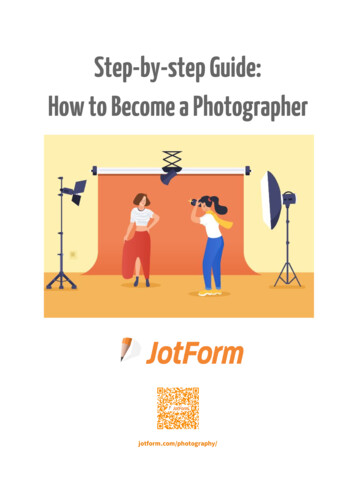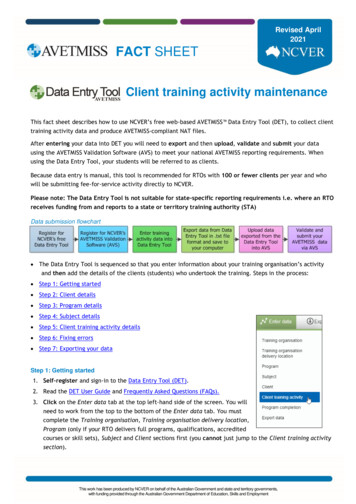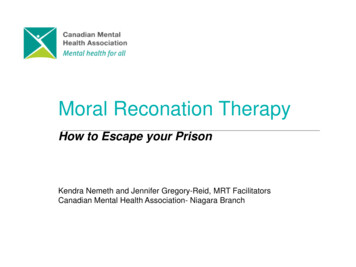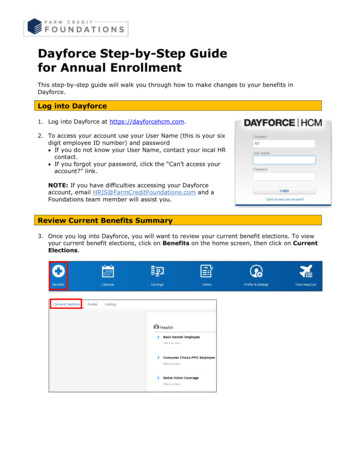
Transcription
Step-by-step Guide:How to Become a Photographerjotform.com/photography/
How to Become a Photographer, Try JotForm for FREE! 2
Introduction4How to know if photography is right for you5Knowing yourself5Choose photography because you love it7Becoming a professional photographerPractice makes perfectEducation can take you to the next levelFormal photography education891113Rule of thirds15Getting feedback makes you better16Learn how to self-edit — and self-criticize17Deciding on your educational path19Finding the right equipment and tools20Choosing a camera21Which camera type is the best for you?22Use some of these popular online photography tools22Finding the right laptop22Lenses, tripods, and lights — oh my!24Mastering photo editing25Setting up your photography business: Where to start28Popular types of photography29How to make money with photography29What’s the best drone for photography?30Promoting your photography31Self-promote with some business cards32Setting up a portfolio and website32Spread the word on social media33Network in the photography world35Optimizing your business — and making more profit37How can JotForm help you optimize?38Saving time and money with JotForm39Common photography forms40Customer feedback can go a long way41How to Become a Photographer, Try JotForm for FREE! 3
Introduction“My life is shaped by the urgent need to wander and observe — and my camera is my passport,”says famous American photographer Steve McCurry. Whether you’re a professionalphotojournalist snapping pictures on the front lines or a novice photographer just starting out,there is something inside that drives people to dedicate their time to photography.People become photographers for different reasons — a passion for aesthetics, an eagerness totell stories , a desire to better understand the world around them, or maybe just a simple butunexplainable passion for capturing moments on film.How do you become a professional photographer?1. Know yourself. Decide if photography is right for you.2. Build your skills. Practice. Take photography classes or get a photography degree. Learnhow to edit photos. Practice some more.3. Find the right equipment and tools. Choose a camera, tripod, lights, and lenses. Invest ina good laptop and photo-editing software.4. Set up your photography business. Decide on a type of photography to pursue. Developa business plan. Create and implement a marketing strategy. Network with otherphotographers.5. Optimize your business. Simplify and automate business processes, such as schedulingappointments, obtaining session agreements and release forms, gathering customerfeedback, and more with JotForm.How to Become a Photographer, Try JotForm for FREE! 4
How to know if photography is right foryouBefore embarking on photography as a career, you’ll want to make sure this is absolutely the rightfield for you. That’s because, at the end of the day, photography demands passion and sacrifice —of course, those sacrifices can yield rewarding outcomes. You will have to spend time, energy, andprobably some money to get really good at it. So before you dive in, it’s worth taking the time toevaluate whether or not you have the right personality for the world of photography.Are you ready for the long hours and possible frustrations that come with photography? Are youpassionate enough to withstand the ups and downs a beginning photographer faces? Answerthose questions, and you’ll have a better understanding of whether or not photography is right foryou.Knowing yourselfWho are you? OK, that’s a pretty big question. To make things easier, here are three slightly morespecific questions: What gets you excited to wake up in the morning? Which three adjectives would you use to describe your personality? What kind of work brings you satisfaction?Together these questions get at what motivates you and how you behave in certainsituations. Your answers may be broad — and some of them might be only vaguely related tophotography or not related at all. For instance, maybe your answer to the first question is “yourfamily.” Although this answer isn’t directly related to photography, it might hint at what motivatesyou to start a photography business. You may want extra funds so that you can better supportyour family financially — and maybe you’re passionate about capturing other families’ memorieswith your camera.How to Become a Photographer, Try JotForm for FREE! 5
None of your answers to these questions specifically qualify or disqualify you frombecoming a photographer. Instead, answering these questions prepares you for what’s ahead.They make you aware of the strengths and weaknesses that you bring to photography. If, forinstance, you said you’re “impatient,” you’ll want to keep that in mind as you learn photography.Are you a procrastinator? Again, good to know.Your working habits and how you relate to your work are also helpful to understand. Forinstance, maybe you’re someone who thrives on outside validation. You need someone beside youto keep you going and remind you why the work you’re doing matters. Unfortunately photographycan be a bit lonely — spending late nights in the darkroom or hours alone on your laptop editing.You’ll need to go out of your way to get feedback from others and set up a support system bothinside and outside of the photography world. These topics — getting feedback and creating anetwork — we’ll discuss later.“Knowing yourself is the beginning of all wisdom,” said Aristotle. It’s a wisdom that willcome in handy as you embark on your budding photography career. Get ready to work hard — andreap lasting rewards.How to Become a Photographer, Try JotForm for FREE! 6
Choose photography because you love itMany people come to photography as a way to make some money. It’s no wonder why:Many people around the world support themselves with photography, turning it into a lasting andfulfilling career. Countless advertising agencies and publications need photographers to providethem with content — and they pay handsomely. It’s also a perfect “side hustle,” allowing you thefreedom to make your own hours and earn sizable hourly income on a freelance basis. To top it off,photography engages your creativity in a world where creative careers are harder and harder tocome by.Unfortunately, becoming a photographer merely because of the money likely isn’t enough of amotivator. You also need to you love photography. Getting those paychecks and turningphotography into a lucrative career is only possible if it’s guided by a real passion for the art. You’llonly be able to put in the time and energy needed for photography if you’re motivated by respectfor your craft.Feeling passionate? Ready to turn photography into a life-changing creative career? Then let’s getto it — because there’s quite a bit to learn about how to become a photographer.How to Become a Photographer, Try JotForm for FREE! 7
Becoming a professional photographerA tourist on 57th Street sees a musician getting out of a cab. He goes over and asks, “How do you getto Carnegie Hall?” Without pause, the musician replies wearily, “Practice.”Everyone can take pictures. Who hasn’t snapped a pretty picture of a sunset during a hike? Ortaken a particularly cute picture of their dog? And almost everyone in the world has taken a selfieat this point. When you take a picture like this, you are technically a photographer. But being aprofessional photographer — someone who gets paid for their work and sees photography asmore than just a pleasant pastime — is entirely different. Take a real-world use case as an exampleand learn how famous photographer , Jeremy Cowart, made it big.What sets professional photographers apart is practice. Pros have honed their craft. They’velabored over photographs, becoming masters (or near masters) of every step in the photographicprocess. And still, they’re always looking to improve, researching the latest photographictechnology, updating their equipment, and taking on new projects that will stretch their skills andtake their mastery further.In this section we’ll stress the importance of practice and explain why it’s such a crucial element ofbecoming a professional photographer. We’ll also explain how to practice — and how to find timeto practice.How to Become a Photographer, Try JotForm for FREE! 8
Practice makes perfectPhotography is a craft — just like metallurgy or shoe cobbling or any other old-timey occupationyou can think of. Crafts require practice. It’s no wonder there are so many photographyapprenticeships. These apprenticeships pair a seasoned professional with a novice so that themaster’s wisdom can pass on to the student.People often confuse “practice” with “learning.” Learning is obviously useful. Reading ahow-to book about photography is immensely valuable, as is looking through a book ofphotographs and evaluating them on a formal level. But practice involves doing. It means goingout into the world with your camera and taking lots of pictures — then developing them, editingthem, and engaging with every part of the photographic process.Along the way you’ll make mistakes; that’s good! Mistakes help you learn. Pushing yourself andsolving new problems is the best way to develop crucial skills and become a more well-roundedphotographer. In fact, going out of your comfort zone and setting yourself up to face challenges isperhaps the most useful means of acquiring new skills.Create goals for yourself. What skills do you want to improve? How are you going to track yourprogress in terms of developing this skill? And on what timeline are you planning to improve?Laying out your goals clearly is important, and tracking your progress is just as vital. Keeping ajournal or a personal blog where you can chart your progress privately or publicly can be useful.How to Become a Photographer, Try JotForm for FREE! 9
Then it’s a matter of determining how you’re going to meet these goals. As we said, the best way tolearn is by doing, and the best way to do is by tackling lots of projects.Create projects for yourself. Tell a friend you’re taking them to the park and photographingthem. They’ll probably be flattered. Sure, this might be something you’ve never done before. Butnow you’ll have the chance to practice composition, getting the lighting right, and workingface-to-face with a client. Not to mention the practice you’ll get editing after the fact. Sitting downand saying, “I’m going to practice landscape photography” can feel too abstract. Creating aproject for yourself forces you to tackle real-world problems and engages lots of different skills allat once. The goal is clear, and it’s up to you to meet it.Mastering photography requires sacrificeAs we’ve discussed, becoming a professional photographer doesn’t happen overnight. You’regoing to have to make some sacrifices along the way. Here are three that stand out:Time: From idea to finished product, taking a photograph can be quite labor intensive. Greatphotographers are often detail oriented. They might spend hours trying to perfect a single elementof a photograph. So as you tackle projects and dedicate yourself to improving your craft, youmight find that you’re dedicating quite a chunk of time to photography. That’s just a reality ofphotography: You sacrifice lots of time along the way. If you love what you’re doing, the time willfly by. You might look up from your laptop after an epic editing session and realize it’s 3 a.m. It’s upto you to determine if the time you’re spending is worthwhile and to create an environment whereyou can improve as a photographer while keeping up with your other responsibilities.How to Become a Photographer, Try JotForm for FREE! 10
Energy: Between traveling to gigs, networking, and running a business — not to mention theactual act of taking photographs — photography will take some energy out of you. Don’t burdenyourself too much early on, or you might end up getting burnt out. Pace yourself, and realize it’sOK to ask for help.Money: Photography is a pretty expensive endeavor in the early going. Getting the right camera —not to mention lenses, lighting equipment, etc. — can make a dent in your paycheck. There’s noreal way around this, though you can start out slow. Maybe wait to invest in a top-of-the-linecamera. Technology has come a long way, and you can find an affordable camera that meetsalmost all of your needs. You can even learn a lot from taking photos on your smartphone camera.There are also some very cheap and even free versions of editing software online. So while there isa financial sacrifice involved in becoming a photographer, you have some control over just howmuch money you spend early on. And ultimately, the money you spend is a worthwhile investmentin terms of advancing your career.Education can take you to the next levelHaving a solid photography education tends to separate hobbyists from professionals. Sure, therehave been plenty of successful photographers with only a minimal educational background. Butfor most, taking classes and working with an instructor enable you to hone your technique andgain valuable experience.How much can you self-teach? You often hear about “self-taught masters” — people who ignoredthe classic paths laid out by academic programs and forged their own way to photographicmastery. And self-teaching could very well be the first step you take. There are countlessinstructional articles and videos online that can give you a basic understanding of the techniquesprofessional photographers use every day. The downside of this approach is the mentorship youlack from not working with an instructor and the inability to give and receive feedback, whichhaving classmates allows you to do.How to Become a Photographer, Try JotForm for FREE! 11
How do you know you’re ready for more education? Maybe you’ve been working as a hobbyistphotographer but have decided to take your skills to the next level. But are you even good enoughto take a beginner class? You should never be afraid of taking the next step and educating yourselfabout photography if you have a passion for it. There are classes out there designed for completebeginners. Even many photography programs consist of students who have only cursoryknowledge of photography.What’s your budget? Of course, there are logistical concerns. After all, education requires timeand money. Though we’ll discuss this more, you’ll want to be aware of how much money you’rewilling to spend on your photography education. There are a wide range of options, from priceygraduate programs to more affordable online courses. You simply need to assess your goals anddecide what provides the best value for you.How to Become a Photographer, Try JotForm for FREE! 12
Formal photography educationNow that you’ve decided to embark on a formal photography education, it’s time to explore youroptions. The types of photography instruction available are diverse. Here are the three worthfocusing on: Online photography courses: The benefits of an online course are obvious — you don’thave to leave your house. Working online allows you to follow an instructor’s lead withouthaving to worry about going to a physical classroom. This also means you can work on theclass on your own time, which is great for busy people seeking flexibility. At the same time,online courses don’t allow for as immersive an experience because you aren’t interactingwith other students and a teacher in person. Most of these classes offer a certificate uponcompletion.How to Become a Photographer, Try JotForm for FREE! 13
Single photography courses: Instead of a long academic series of courses, you can alsojust take a single course at a learning annex or community center. It may meet once aweek or so and function as a workshop where students can bring in work and get feedbackfrom a classroom of other students at a similar skill level. You can find beginner,intermediate, and advanced classes that touch on a variety of different photography types.If you’re in a major city, you probably have more options. Again, many of these classesoffer a certificate, typically if you complete a certain sequence of classes. College photography degrees: The vast majority of colleges have photography programs,and there are many great graduate photography programs around the world. Art schoolsand photography colleges can offer rich, interdisciplinary exposure to the subject.Undergraduate courses can help beginners get acquainted with photography. But agraduate program is for the most serious photographers and usually touches on more thanjust technique — such as photographic history and critical analysis of famousphotography. Those who complete a graduate photography degree typically earn a Masterof Fine Arts (MFA), which can be a helpful degree to have when seeking out photographyjobs.Fundamentals come firstWhat exactly do photography classes teach you? At the heart of every photography class is anexploration of the fundamentals of photography. Beginner courses will coverHow to Become a Photographer, Try JotForm for FREE! 14
How a camera works: You can’t take pictures without a camera, so most beginner courseswill take a deep dive into what sets different cameras apart. Courses will explore howlenses work, how exposure works, and then outline different shutter systems and howshutter speed impacts the photos you take. You’ll ideally come away understanding howto adjust your camera — and its lenses, exposure, and shutter speed — given certainsituations. To get an idea of the impact of these fundamentals, here are some stunningexamples of long exposure. Composition: At its heart, photography is about composing photos for a desired effect.Learning the basics of composition is fundamental to a photographer’s education. Wheredo you place objects in the frame of the shot? How can you adjust the composition of yourshot to highlight the subject in a particular way? Perspective, background, and layers allplay a role as you bring the three-dimensional world to life in your photographs. Depth of field: Understanding how the aperture on your camera works can help you solvecompositional problems and unleash memorable visual effects. Knowing your way aroundthe aperture is fundamental to good photography and, once mastered, can take your workto the next level. Lighting: Add dimension and mood to your photographs with lighting. Most instructorswill tell you that lighting is often misunderstood and misused. Aiming for subtlety with thecolor and intensity of your lighting can have a profound effect on your work’s quality. Mostclasses will also typically cover ambient light, hard and soft light, and introduced light —and explain how to introduce these elements into your photography in a way that’seffective. Editing: Although many beginner classes will focus on the most basic tenets ofphotography and prioritize familiarizing students with their cameras, lots of classes willwade into the important task of editing. Photo editing has evolved over the years as newdigital tools make it easier than ever to tweak shots after the fact. You rarely can edit a badshot into something that works — hence the importance of fundamentals — but editingcan take a good shot to a whole other level.Rule of thirdsOne fundamental principle of photography that you’ll learn is the rule of thirds. This rule helps youcarefully compose photographs and can be applied to many different types of photography. It’sone of the first things you’ll learn in a beginner photography class — and something you’ll keep inmind throughout your career.Getting feedback makes you betterJust about the best part of working with other students in a classroom is getting regular feedback.This feedback comes from your classmates as well as the instructor — and both provide valuablecriticism that you can use to make your photographs better. Here are a few things to keep in mindwhen receiving feedback:How to Become a Photographer, Try JotForm for FREE! 15
Listen first. When you receive feedback, you’re learning. You’re seeing your work through someoneelse’s eyes, cutting away your personal connection to the work so that you can understand it froma new perspective. That’s why you need to sit back and listen. In fact, most workshops will wiselyhave multiple students chime in with feedback before letting the photographer respond. Thisplaces the focus on those who are looking at the work rather than the creator of the work.Ask the right questions. Once you’ve listened to what your classmates and instructor have to say,it’s time to respond with questions that will help you improve. For instance, if any feedback feltvague (e.g., “This photo didn’t really have an impact on me.”), ask for clarification. What about thephoto failed to strike a chord? Ask tactical questions. See if any of your classmates have favoritephotos that might have come to mind when they were assessing your photos, and then take a lookat those photos.Let your instructor’s feedback motivate you. In an ideal setting, your instructor will becomesomething of a mentor for you. So you will naturally look forward to their feedback the most. Infact, you’ll probably earn a letter or number grade from them. While grades can be stressful,they’re a great way to motivate you and enhance your work. If you got a lower grade thanexpected, let this be an inspiration to improve. If you got a high grade, you’ve raised expectations— now it’s up to you to follow up on these expectations.How to Become a Photographer, Try JotForm for FREE! 16
Don’t take it personal. Receiving feedback isn’t easy, especially if it’s negative. You’re bound tofeel vulnerable. Suddenly the spotlight’s on you, and people aren’t afraid to call out the flaws ofyour work. It’s stressful — and takes a thick skin. The most important thing to remember is thatyou can’t take criticism personally. See honest criticism as a gift. When someone tells you exactlyhow they feel about your work, you’re getting a valuable glimpse into the way the world respondsto your work. You can use this information to adjust and optimize. After all, this criticism is focusedon your work — and says nothing about you as a person.Enter photo contests. Want to guarantee some feedback outside of the classroom? A photocontest is a great option. It puts your work in front of a panel of judges who will not only tell youwhat they think of your work, but also potentially reward it, often in the form of money (not a baddeal, eh?).If you aren’t in a class, find ways to actively seek out feedback. Turn to friends, family, and anyoneelse whose opinion you respect to hear how they feel about your work. Doing this consistently willteach you and help you become more aware of the impact of your work.Learn how to self-edit — and self-criticizeYou won’t always have access to a roomful of classmates willing to give you feedback. When you’regoing over your photos alone in the darkroom or editing them on your laptop, you’ll find it’s timefor some self-editing. This tends to be more difficult than getting feedback from an outside source.You often have personal feelings wrapped up in your work. So how do you go about effectivelyself-editing so that you can improve your work?Remove your personal attachments. You spent hours getting a photo just right. The labor thatwent into this photo might make you more protective of its quality — and keep you from beinghonest with yourself about it. Or you might come down too hard on this photo if you’redisappointed in the final product. Regardless, self-criticism is all about removing your personalfeelings and looking at your work objectively. Depersonalize so that you view your work in thesame way a classmate would. This takes practice.How to Become a Photographer, Try JotForm for FREE! 17
Focus objectively on the fundamentals. Where should you focus your criticism? On thefundamentals. Recall what you learned in class (if you are taking or have taken a class). Go throughthe basics of exposure, composition, and lighting. What works well, and what could be improved?What do you think your instructor would say about your handling of the fundamentals? Whatfundamental of photography do you think you need to focus on improving when taking your nextphoto? Keying in on the fundamentals will keep your self-editing objective and turn the processinto a powerful learning experience.Be your own worst critic — but be kind to yourself. Don’t be afraid to be ruthless with yourself-criticism. For many artists, this is natural. Being your own worst critic can be a valuable tactic.It can help you to strive to improve and never feel complacent about your skills or the work you’reproducing. But if you are going to be hard on your work, make sure you cut yourself some slack. Ifyou’re a new photographer, remember that you’re still improving. Some work you make will bedisappointing. All that matters is that you don’t lose motivation and you move onto the nextproject with enthusiasm and confidence.Enter workshop mode. Sometimes looking at a photo and assessing your response to it isn’tenough. Many people find it helpful to reflect on their photo out loud, as though they’re speakingin workshop. You get out of your own way a bit when you do this and have the chance to speakobjectively. Alternatively, writing a few sentences about your response to your photo is a good wayto organize your thoughts. Saving this written feedback can be valuable, as you can look back onyour work with some distance and see how your reaction to it changes over time.How to Become a Photographer, Try JotForm for FREE! 18
Deciding on your educational pathAs we’ve discussed, you have plenty of options when it comes to your formal photographyeducation. And as we’ve seen, most classes tend to focus on similar fundamental concepts. As youdecide on your educational path, you need to ask yourself a few questions:What are your goals? Where do you want photography to take you? Do you want it to be afull-time job? An especially rewarding hobby? A fun and lucrative side hustle? Knowing your goalsand scaling your educational path alongside your goals is a good way to decide on the right kind ofprogram.Who are your idols? There’s probably someone out there in the photography world who has abody of work or career that you admire. See what they did in terms of education. You don’t have tocopy them. But knowing who you look up to and understanding how they got where they are is agood way to decide on the right educational path.What is your current life situation? Maybe you’re at a point where entering a graduate programis out of the question. That’s OK. You need to be realistic. Maybe you take an online course, earnan online photography degree, and make some money as a photographer for a few years beforeyou have the earnings and confidence to pursue a more advanced photography degree at acollege. It’s not always a straight line from “beginner photographer” to “professionalphotographer.” Embrace the detours while keeping your overall plan in mind.What kind of photography do you enjoy the most? Different classes and programs focus ondifferent things. Are you looking to do commercial photography? More artistic photography? Whatkind of earning potential are you looking for? Do you want a class that touches on photographichistory and art criticism? These are all things to consider when choosing a class.Before signing up for or applying to a class, reach out to any valuable resources. These could beadmissions officers, former students, or instructors. Explain your goals and see if the class contentmatches up with those goals. Go on a tour of a photography school and do plenty of onlineresearch. You’re making a big, exciting decision when you decide on an education path. Take itseriously and weigh your options carefullyHow to Become a Photographer, Try JotForm for FREE! 19
Finding the right equipment and toolsIn many ways, mastery in photography is about mastery of tools. It’s a craft that forces you tounderstand machinery on a deep level: How does a different lens alter the way a photographlooks? What lighting equipment do you need to evoke a specific mood?Having the right equipment makes everything easier. But finding the right equipment isn’t simple.Different types of photography call for different tools. There are certain cameras that transcendtype and work in a variety of settings. And when you’re starting out, it’s probably best to go withequipment that is fairly general. After all, you’re still exploring and learning your way around acamera. So it’s best to choose a camera that helps you explore as widely as possible.Another complicating factor is the evolution of different technologies. It feels like there’s a newcutting-edge camera released every day, but it’s best not to get caught up in the latesttechnological advancements. Always looking for the “next best thing” in photographic equipmentis usually a waste of time and can put a real dent in your bank account. Instead, find the camerathat’s right for you and learn how to use it inside and out.As your photography skills grow, you’ll find that you aren’t just buying a camera. You’re insteadbuying a collection of photographic equipment that works together to help you produce your bestwork. You want a camera, photo editing software, and a laptop that all work for you, as well as ahost of other tools that help take your photos to the next level. In this section we’ll explore thisequipment and outline which tools work best in which contexts.How to Become a Photographer, Try JotForm for FREE! 20
Choosing a cameraChoosing a camera is one of the biggest decisions a new photographer makes. And as you grow,you’ll likely need to seek out new cameras. That’s why learning how to choose a camera canbecome a skill unto itself. While this might fe
Build your skills. P ractice. Take photography classes or get a photography degree. Learn how to edit photos. Practice some more. 3 . Find the right equipment and tools. Choose a camera, tripod, lights, and lenses. Invest in a good laptop and photo-editing software. 4 . Set up your photography business. De











